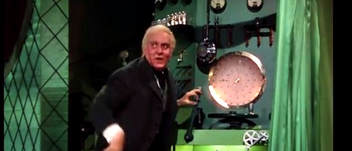weekly column
|
Each week, find a commentary on something connected to verses of Torah or another source of wisdom
|
|
Each week, find a commentary on something connected to verses of Torah or another source of wisdom
|
 The Exodus:5 Project Make fifty loops on the one cloth, and fifty loops on the edge of the end cloth of the other set, the loops to be opposite one another. Exodus 26:5 The institutionalization of religious skepticism in this country may very well be traced to a line of dialogue in the movie “The Wizard of Oz.” (Spoiler alert) When the little dog Toto pulls back the cloth that conceals the wizard, revealing him to be nothing more than an illusionist, he attempts to gain his status back by making his projected giant head say, “Pay no attention to the man behind the curtain!” Like most of you, I have deployed that line in many circumstances. More than twenty years ago, when the synagogue I served was under renovation, we conducted High Holy Day services in a local church. They were completely accommodating when we asked if we could construct a screen that would conceal the stained-glass representation of Jesus that presided over the front of the sanctuary. When I arrived on the morning of Rosh HaShanah, I realized that the church’s architect had taken advantage of the sun’s position on Sunday mornings to illuminate the giant glass mural. Projected onto the screen, even more ethereal than in the glass, was the human likeness. Never have I had a better opportunity to say, “Pay no attention to the man behind the curtain.” I don’t know if Noel Langley, who wrote the script, knew he was giving voice to the doubt that plagued so many. While the sentiment was not new – after all, the same premise is the point of “The Emperor’s New Clothes” – the notion that ruling authority relies on illusion and concealment rather than honesty and transparency mostly applied to political cynics. It still does. But the Wizard of Oz himself was part emperor, part priest and part god. If ever, oh ever, a wiz there was, the Wizard of Oz is one because…well, because of his cultivated reputation. In the movie, he is exposed to be a carnival performer. (In the book, he has a bit more prestige.) And once the curtain has been pulled back, his four petitioners call him what he admits he is: a humbug. As a piece of entertainment, it is a great denouement. But over the few generations that the movie has impressed itself on generations, it also planted the seed about pulling back other curtains that conceal those who would call themselves wizards or emperors or priests or even gods. It adds to the irony that in ancient times, before streaming or even VHS tape, “The Wizard of Oz” was broadcast every year at Easter and Passover, the time of miracles, quests and looking for home. And I also note that one of my children who liked playing rabbi at three years old decided at age five that when she grew up, she wanted to be Dorothy. These days, every curtain begs to be opened. Whether the manipulations behind are thus revealed or we discover that there really is nothing back there, we demystify every tantalizing spiritual mystery we encounter. Those of us who have been disabused of our grandparents’ faith have more than a tendency to look askance at the segment of our population that prefers to keep the curtains closed, attributing to them a sort of willful ignorance. We presume that if they want the curtains closed, they also want the closets closed, the gates of heaven closed to people unlike themselves and, ultimately, their minds closed. It may be true of some, but no less true of some skeptics. Perhaps they do not want to know first-hand what Noel Langley introduced to the movie-going public: there is nothing behind the curtain that isn’t already on the other side. After all, the Scarecrow, Tin Man and Lion all get what they came to get. The diploma, the clock and the medal are no more repositories of wisdom, compassion and courage than the wizard’s projector bestows authority. Everything everyone needed was at hand, waiting to be recognized. The little fragment of instruction that makes up this verse is about the curtains that surrounded the Tabernacle. When the portable sanctuary was erected on otherwise unremarkable ground, it created a visual reminder of the intersection of the fantastic and the everyday, the sacred and the secular. The land was neutral. The curtains (and everything else) were made by human hands. But in constructing this designated precinct, the Israelites were hoping not to conceal, rather to reveal. God had promised that if they built it, then the divine presence would abide. As so many of my teachers have noted, the promise was not to abide in it (i.e., the Tabernacle), but to abide in them (i.e., the Israelites themselves). The man behind the curtain discovered that his real power was within, just as surely as wisdom, love and courage. And as for Dorothy, she pulled back the curtain of dreams to live a full and grateful life in the place she called home. More and more Americans are religious skeptics, and we may be able to trace that to “The Wizard of Oz.” But we don’t really need smoke and mirrors to discover the gifts that empower us and give our lives meaning. The curtains were made by us reveal our potential, not to conceal a wizard.
0 Comments
Leave a Reply. |
Archives
October 2023
Categories |